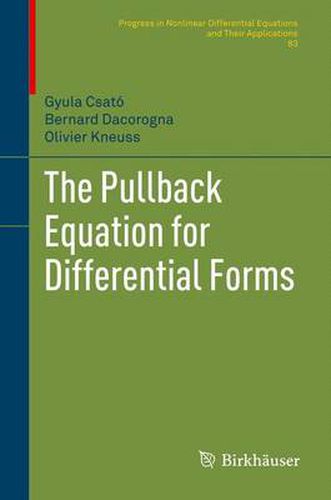Readings Newsletter
Become a Readings Member to make your shopping experience even easier.
Sign in or sign up for free!
You’re not far away from qualifying for FREE standard shipping within Australia
You’ve qualified for FREE standard shipping within Australia
The cart is loading…






This title is printed to order. This book may have been self-published. If so, we cannot guarantee the quality of the content. In the main most books will have gone through the editing process however some may not. We therefore suggest that you be aware of this before ordering this book. If in doubt check either the author or publisher’s details as we are unable to accept any returns unless they are faulty. Please contact us if you have any questions.
An important question in geometry and analysis is to know when two k-forms f and g are equivalent through a change of variables. The problem is therefore to find a map
so that it satisfies the pullback equation: *(g) = f.
In more physical terms, the question under consideration can be seen as a problem of mass transportation. The problem has received considerable attention in the cases k = 2 and k = n, but much less when 3
k
n-1. The present monograph provides the first comprehensive study of the equation.
The work begins by recounting various properties of exterior forms and differential forms that prove useful throughout the book. From there it goes on to present the classical Hodge-Morrey decomposition and to give several versions of the Poincare lemma. The core of the book discusses the case k = n, and then the case 1 k
n-1 with special attention on the case k = 2, which is fundamental in symplectic geometry. Special emphasis is given to optimal regularity, global results and boundary data. The last part of the work discusses Hoelder spaces in detail; all the results presented here are essentially classical, but cannot be found in a single book. This section may serve as a reference on Hoelder spaces and therefore will be useful to mathematicians well beyond those who are only interested in the pullback equation.
The Pullback Equation for Differential Forms is a self-contained and concise monograph intended for both geometers and analysts. The book may serve as a valuable reference for researchers or a supplemental text for graduate courses or seminars.
$9.00 standard shipping within Australia
FREE standard shipping within Australia for orders over $100.00
Express & International shipping calculated at checkout
This title is printed to order. This book may have been self-published. If so, we cannot guarantee the quality of the content. In the main most books will have gone through the editing process however some may not. We therefore suggest that you be aware of this before ordering this book. If in doubt check either the author or publisher’s details as we are unable to accept any returns unless they are faulty. Please contact us if you have any questions.
An important question in geometry and analysis is to know when two k-forms f and g are equivalent through a change of variables. The problem is therefore to find a map
so that it satisfies the pullback equation: *(g) = f.
In more physical terms, the question under consideration can be seen as a problem of mass transportation. The problem has received considerable attention in the cases k = 2 and k = n, but much less when 3
k
n-1. The present monograph provides the first comprehensive study of the equation.
The work begins by recounting various properties of exterior forms and differential forms that prove useful throughout the book. From there it goes on to present the classical Hodge-Morrey decomposition and to give several versions of the Poincare lemma. The core of the book discusses the case k = n, and then the case 1 k
n-1 with special attention on the case k = 2, which is fundamental in symplectic geometry. Special emphasis is given to optimal regularity, global results and boundary data. The last part of the work discusses Hoelder spaces in detail; all the results presented here are essentially classical, but cannot be found in a single book. This section may serve as a reference on Hoelder spaces and therefore will be useful to mathematicians well beyond those who are only interested in the pullback equation.
The Pullback Equation for Differential Forms is a self-contained and concise monograph intended for both geometers and analysts. The book may serve as a valuable reference for researchers or a supplemental text for graduate courses or seminars.